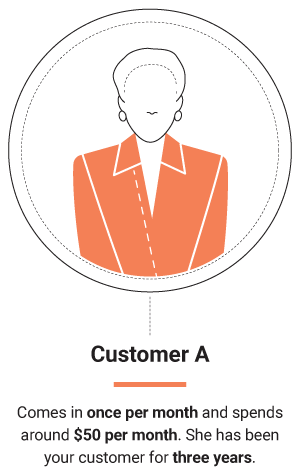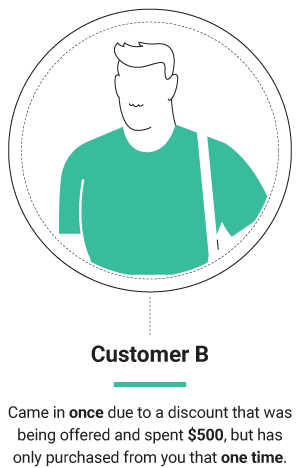It’s natural for business owners to want to attract more customers. After all, customers are the reason any business exists.
But it might surprise you to learn that keeping existing customers engaged can be more beneficial to your bottom line than constantly chasing new leads.
How do we figure?
Let’s look at the math.


Customer A has spent around $1800 with you whereas Customer B only spent $500.
So, while Customer B may appear at a glance to be the type of customer you want walking through your doors, Customer A is earning you more revenue in the long run.
Needless to say, retaining high-value customers like this should be the focus of your sales and marketing efforts. This is where CLV or Customer Lifetime Value comes into play.
Whether you’re asking yourself, What is Customer Lifetime Value? Or how do I calculate customer acquisition cost vs lifetime value? Keep reading.
All the answers are below.
What is Customer Lifetime Value
This metric is by definition the “worth” of a customer to a business over the course of the relationship. In other words, it’s how much money a business can make from an individual.
Whether you’re a retailer servicing its customers every season or an insurance company working with annual subscriptions, CLV applies.
The happier your customers are, the longer they will stay with your business, thus adding to their CLV.
And that’s something you want given that acquiring new customers is estimated to cost as much as 5x to 25x more than simply retaining your existing customers.
Calculating you CLV
As with any measurement, it’s important that you collect specific numbers in order to get a more accurate picture of your results. When it comes time to calculate lifetime value of customers, here is the data you’ll need:
Average Purchase Value (APV): Divide your total revenue within a specific time period (ie: a month, a year) by the total number of purchases within that same time period.

Example: If your business earned $10,000 in revenue in one month from 100 sales, your APV for that period of time is 100.
Average Purchase Frequency (APF): Divide the number of purchases that are made within a specific time period by the number of unique customers within that same time period.

One customer who made several purchases within this time period should only be counted one time.
Example: Your business earned $10,000 in a year from 20 customers who together made 100 purchases meaning your average purchase frequency is 5.
Average Customer Lifespan (ACL): Add up the lifespan of all your customers and divide it by your total number of customers.

When your business is new, it’s not possible to get an accurate number for this—so there’s another way. You can also determine ACL using your churn rate. Your churn rate is the number of customers your businesses is losing.
The formula for this is 1 divided by your churn rate.

Now, to calculate lifetime value of customers you need to multiply all of your data together.

Gross Margin: For an even more accurate CLV you can utilize your gross margin to give you a clearer picture of profits per customer.

Improve Your CLV
Once you know the answers to questions like What is Customer Lifetime Value or how to calculate lifetime value of customers you might find yourself wondering how you can build a long-term connection with customers and increase your CLV.
In most cases, it comes down to your treatment of your customers. And while you may already be doing a good job of this, there is always room for improvement. Check out these opportunities for increasing CLV.
1. Streamline Your Onboarding Process
How well do you educate new customers about your brand? This includes things like telling them what you do, why you do it and why that matters, as well as why they should continue to do business with you.
Usually, this process occurs in the days following an initial purchase. From sending an email welcome sequence to offering a discount for additional purchases to ensuring your website offers an easy-to-follow user experience, you have the opportunity to start building connections to your brand immediately, potentially increasing customer retention.
2. Listen to Feedback
Every business is going to shine in areas while seeking improvement in others. While it can be a hard pill to swallow, taking a look at reviews of your business or reading negative feedback from customers can go a long way toward knowing what you need to work on, ultimately improving your CLV. Because when customers feel like they’re being heard, they’re more likely to maintain loyalty.
3. Increase order amounts
As your CLV calculations depend, in part, on the sales you’re earning, it makes sense to ensure that you’re maximizing every sale you make.
How can you do this?
By offering additional products or services that may be of use to your customer.
For instance, if you’re an art supply store and a customer comes up to the checkout with new paints, you could tell them about the new paintbrushes you recently got in or even ask if they need paper or a canvas.
Or a bakery that sells someone a coffee might offer to add on a fresh baked muffin for only $0.99.
Even subscription-based products and services have an opportunity to increase order amounts by offering monthly versus annual billing.
4. Start a loyalty program
Your customers love being rewarded for making purchases. And when you use a loyalty program, you’re rewarding not only your customers, but your business, too, because you’re encouraging customers to make a repeat visit.
From points to benefits to discounts, a loyalty program can be anything that works for the type of business you’re running.
5. Join the social conversation
It’s here to stay, and for good reason. Social media is an amazing way to tap into who your customers are and what they need. Moreover, it’s a great way to build connections easily through responding to customer comments and concerns, sending private non-canned messages, or even utilizing live videos.
It’s also a way to ensure your brand remains in front of customers, even when you’re not on their mind.
6. Use multiple communication channels
In time, you will get a good idea of how your customers prefer to communicate. And while there may be a channel that they prefer over others, multi-channel marketing is still a powerful tool when building connections.
Ensure your business is using multiple communication channels (email, direct mail, and online ads, for instance) that have variance in message but a uniformed strategy so you’re always staying in touch with your customers.
7. Invest in your customers
As far as business goes, you may think that it’s only your customers who need spend money with you. In reality, spending money on existing customers is a great way to increase their loyalty to your brand.
This can be anything from a freebie (thanks for doing business with us! Here’s a free gift.) to spending money on the latest tech or software to ensure a smooth checkout process for customers.






